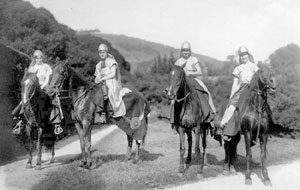|
HOME | SEARCH | ARCHIVE |
|
By D. Lyn Hunter, Public Affairs
| |
 Every year, beginning in 1911, Cal held a competition for an original play by an undergraduate woman about the transition from girlhood to adulthood. The winning play was performed by as many as 500 women, in an event called the "Partheneia," at first held under the oaks by the eucalyptus grove and then in Faculty Glade. The tradition died out in 1931. Above is a scene from the 1916 performance. UC Berkeley Archives photo. |
11 OCTOBER 00 | Back in the late 1800s, Berkeley freshmen held an elaborate funeral service for textbooks at the end of each academic year.
In a tradition known as the Burial of Bourdon and Minto, costumed students held a procession through campus, ending with a ceremonial burning of Bourdon's "Elements of Algebra" and Minto's "Manual of English Prose Composition."
That tradition ended in 1903, but there are many others that the UC Rally Committee - celebrating 100 years as keeper of Cal traditions - has kept alive for class after class of Berkeley students.
"There are a lot of Cal traditions to keep track of, both sports-related and otherwise," said Nick Maracich, committee historian. "Many died out long ago, as times and tastes changed, but others continue today. Our job is to keep them all alive, either in memory or in practice."
Cal lore, past and present, will be the focus this weekend as alumni and parents gather on campus for Homecoming, Reunion and Family Weekend. Some things alumni may remember fondly, which the rally committee tries to keep alive year after year, include:
- Oski the Bear - Named after the famous Oski yell, first performed around the turn of the century, Oski is the official Cal mascot. He originally appeared in 1941, the night before the season-opening football game, and has been prowling the campus ever since. Oski stands 5 feet, 7 inches, and wears size 14 tennis shoes. He never speaks and his identity is never revealed.
- The Pajamarino Rally - Begun in 1901 by students who wanted to have a rally that was genuinely California. They distributed thousands of leaflets around campus announcing a "Pajamahoolo." The gathering, and its pajamas-only dress code, proved hugely popular and continued into the 1950s. However, an attempt to revive it in 1986 failed.
- They're Hanging Danny Deever in the Morning - At noon on the Friday before the start of finals, this song is played on the Campanile's carillon. When the song is over, the bells remain silent until the end of finals the following week. Normally, the bells are played every weekday morning and afternoon. The tradition began in 1930.
The original focus of the UC Rally Committee was to plan and stage rallies, said Maracich. "But in 1927, the group was designated as the official guardian of all campus traditions - a charge that, to this day, we take very seriously."
Most Cal traditions alive today are related to athletics, and Rally Committee members are the biggest Golden Bear fans around. Without them, there would be no card stunts (which Cal invented), no Big "C" up in the hills, no bonfires and no cannon booms for each Bear touchdown scored in Memorial Stadium.
The group also is the official custodian of the Stanford Axe - the perpetual trophy for the winner of the annual Big Game between Cal and Stanford - when the axe is in Cal custody. Devoted members sleep with it, in the days before the game, to guard it from theft.
Though the Rally Committee is busy all year long, things kick into high gear during Big Game week in early November. The group organizes a slew of events devoted to this classic football battle, held annually since 1892, between "Stanfurd," (Cal's unofficial spelling of the Palo Alto university) and the Bears.
Two weeks before the game, the committee sets up an elaborate security system to guard the axe trophy, Memorial Stadium and the Big "C" from Stanford pranksters. There also is a Cal-Stanford Sing-off, a festival celebrating the vocal talents of both schools.
One of the most involved activities is the bonfire rally, held the Friday before Big Game in the historic Greek Theatre. As darkness falls, the bonfire is ignited with a mighty boom and the marching band charges onto the stage playing "Fight for California."
While the pyre burns, the audience is entertained with storytelling and traditional cheers, such as the Cal Hakka and the Axe Yell. The rally traditionally concludes with a reading of "The Spirit of California" - the glow of the fire providing the only light.
When the rally is over and the theatre has emptied out, committee members roast marshmallows on the remaining embers of the bonfire in honor of their hard work.
And if you hear singing on campus on the nights before home football games, chances are it's members of the Rally Committee gathered around the Campanile to perform Cal songs and cheers as part of their "Midnight Sing."
In addition to the traditions guarded by the Rally Committee, the campus celebrates other milestones in Berkeley history, such as Charter Day, which commemorates the founding of the university on March 23, 1868.
Home | Search | Archive | About | Contact | More News
Copyright 2000, The Regents of the University of California.
Produced and maintained by the Office of Public Affairs at UC Berkeley.
Comments? E-mail berkeleyan@pa.urel.berkeley.edu.